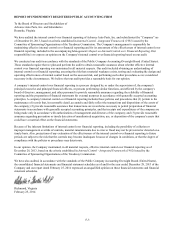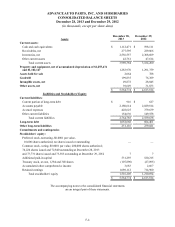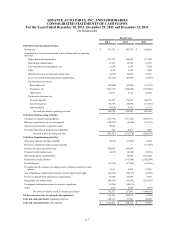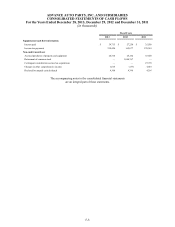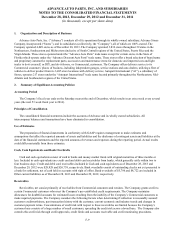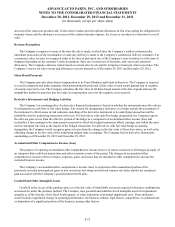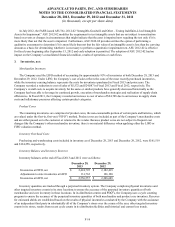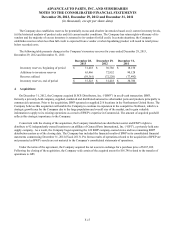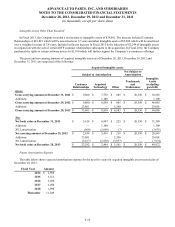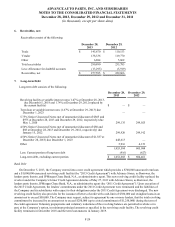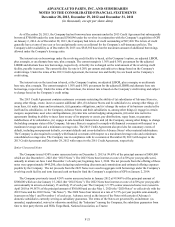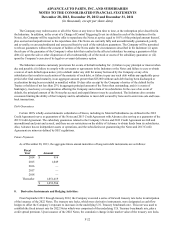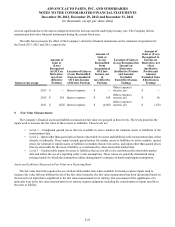Advance Auto Parts 2013 Annual Report Download - page 65
Download and view the complete annual report
Please find page 65 of the 2013 Advance Auto Parts annual report below. You can navigate through the pages in the report by either clicking on the pages listed below, or by using the keyword search tool below to find specific information within the annual report.ADVANCE AUTO PARTS, INC. AND SUBSIDIARIES
NOTES TO THE CONSOLIDATED FINANCIAL STATEMENTS
December 28, 2013, December 29, 2012 and December 31, 2011
(in thousands, except per share data)
F-13
Valuation of Long-Lived Assets
The Company evaluates the recoverability of its long-lived assets whenever events or changes in circumstances indicate
that the carrying amount of an asset might not be recoverable and exceeds its fair value.
Significant factors, which would trigger an impairment review, include the following:
• Significant decrease in the market price of a long-lived asset (asset group);
• Significant changes in how assets are used or are planned to be used;
• Significant adverse change in legal factors or business climate, including adverse regulatory action;
• Significant negative industry trends;
• An accumulation of costs significantly in excess of the amount originally expected for the acquisition or construction
of a long-lived asset (asset group);
• Significant changes in technology;
• A current-period operating or cash flow loss combined with a history of operating or cash flow losses, or a projection
or forecast that demonstrates continuing losses associated with the use of a long-lived asset (asset group); or
• A current expectation that, more likely than not, a long-lived asset (asset group) will be sold or otherwise disposed of
significantly before the end of its previously estimated useful life.
When such an event occurs, the Company estimates the undiscounted future cash flows expected to result from the use of
the long-lived asset (asset group) and its eventual disposition. These impairment evaluations involve estimates of asset useful
lives and future cash flows. If the undiscounted expected future cash flows are less than the carrying amount of the asset and
the carrying amount of the asset exceeds its fair value, an impairment loss is recognized. When an impairment loss is
recognized, the carrying amount of the asset is reduced to its estimated fair value based on quoted market prices or other
valuation techniques (e.g., discounted cash flow analysis). There were no material impairment losses in the three years ended
December 28, 2013.
Earnings per Share
The Company uses the two-class method to calculate earnings per share. Under the two-class method, unvested share-
based payment awards that contain non-forfeitable rights to dividends or dividend equivalents (whether paid or unpaid) are
considered participating securities and are included in the computation of earnings per share. Certain of the Company’s shares
granted to Team Members in the form of restricted stock and restricted stock units are considered participating securities.
Accordingly, earnings per share is computed by dividing net income attributable to the Company’s common shareholders
by the weighted-average common shares outstanding during the period. The two-class method is an earnings allocation formula
that determines income per share for each class of common stock and participating security according to dividends declared
and participation rights in undistributed earnings. Diluted income per common share reflects the more dilutive earnings per
share amount calculated using the treasury stock method or the two-class method.
Basic earnings per share of common stock has been computed based on the weighted-average number of common shares
outstanding during the period, which is reduced by stock held in treasury and shares of nonvested restricted stock. Diluted
earnings per share of common stock reflects the weighted-average number of shares of common stock outstanding, outstanding
deferred stock units and the impact of outstanding stock options and stock appreciation rights (collectively “share-based
awards”). Share-based awards containing performance conditions are included in the dilution impact as those conditions are
met. Diluted earnings per share are calculated by including the effect of dilutive securities.
Lease Accounting
The Company leases certain store locations, distribution centers, office space, equipment and vehicles. Initial terms for
facility leases are typically 10 to 15 years, with renewal options at five year intervals, and may include rent escalation clauses.
The total amount of the minimum rent is expensed on a straight-line basis over the initial term of the lease unless external
economic factors exist or become existent such that renewals are reasonably assured, in which case the Company would


